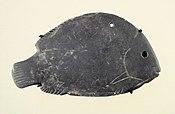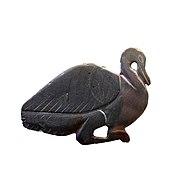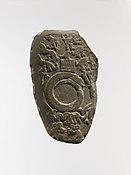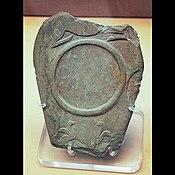
Cosmetic palettes are archaeological artifacts, originally used in predynastic Egypt to grind and apply ingredients for facial or body cosmetics. The decorative palettes of the late 4th millennium BCE appear to have lost this function and became commemorative, ornamental, and possibly ceremonial. They were made almost exclusively out of siltstone with a few exceptions. The siltstone originated from quarries in the Wadi Hammamat.
Many of the palettes were found at Hierakonpolis, a centre of power in pre-dynastic Upper Egypt. After the unification of the country, the palettes ceased to be included in tomb assemblages.
Notable palettes
Notable decorative palettes are:
- The Cosmetic palette in the form of a Nile tortoise
- The Narmer Palette, often thought to depict the unification of Upper and Lower Egypt under the pharaoh Narmer, Egyptian Museum, Cairo
- Libyan Palette, Egyptian Museum, Cairo
- The Four Dogs Palette, displaying African wild dogs,[1] giraffes, and other quadrupeds, Louvre
- The Battlefield Palette, British Museum and Ashmolean Museum
- The Bull Palette, at the Musée du Louvre, named for the bull at the top — obverse and reverse — trampling a man
- The Hunters Palette, British Museum and Louvre
Even undecorated palettes were often given pleasing shapes, such as the zoomorphic palettes, which included turtles and, very commonly, fish. The fish zoomorphic palette often had an upper-centrally formed hole, presumably for suspension, and thus display.
There are also Near East stone palettes, from Canaan,[2] Bactria, and Gandhara.
History of Egyptian palettes
Siltstone was first utilized for cosmetic palettes by the Badarian culture. The first palettes used in the Badarian Period and in Naqada I were usually plain, rhomboidal or rectangular in shape, without any further decoration. It is in the Naqada II period in which the zoomorphic palette is most common. On these examples there is more focus on symbolism and display, rather than a purely functional object for grinding pigments. The importance of symbolism eventually outweighs the functional aspect with the more elite examples found in the Naqada III period, but there is also a reversion to non-zoomorphic designs among non-elite individuals.
List of famous ancient Egyptian Predynastic palettes
| Name | Image | Dimensions | Location | Notes + Topic |
|---|---|---|---|---|
| Battlefield Palette "Vultures Palette", etc. |   | Full Height? 50 x 32 cm-(?) (20 x 13 in) | British Museum | Side A: war; Side B: peace ('Order vs Chaos') |
| Bull Palette |   | 26.5 x 14.5 cm | Louvre | |
| Hunters Palette |  | 30.5 x 15 cm (12 x 6 in) | British Museum Louvre Museum | Only one side is sculpted, the palette is broken in four fragments, one of which is lost. The top-right fragment is on display at the Louvre, accession number E 11254 |
| Libyan Palette |   | Egyptian Museum, Cairo | ||
| Min Palette |  | British Museum | ||
| Narmer Palette "Great Hierakonpolis Palette" | 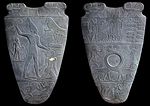 | 64 x 42 cm (25 x 17 in) | Egyptian Museum, Cairo | Narmer's victory over Lower Egypt |
| "Two Dogs Palette" | 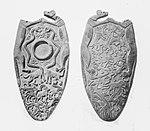 | Ashmolean Museum | ||
| "Four Dogs Palette" |   | 32.0 × 17.7 cm | Louvre Museum |
Other palettes
Fragment of a ceremonial palette illustrating a man and a type of staff. Circa 3200–3100 BCE Predynastic, Late Naqada III.
A rare Naqada III Egyptian Cosmetic palette found beyond Egypt, in Ashkelon or Gaza, end of 4th millennium, Louvre Museum AO 5359.[3]
See also
- List of ancient Egyptian palettes
References
- David Wengrow, The Archaeology of Early Egypt: Social Transformations in North East Africa, Cambridge University Press 2006
- Erik Hornung, Conceptions of God in Ancient Egypt: the one and the many, Cornell University Press 1982
- ^ Baines, J. (1993). Symbolic roles of canine figures on early monuments. Archéo-Nil: Revue de la société pour l'étude des cultures prépharaoniques de la vallée du Nil, 3, 57-74.
- ^ Festschrift, Rëuben R. Hecht, Korén Publishers 1979
- ^ Miroschedji, Pierre de. Une palette égyptienne prédynastique du sud de la plaine côtière d'Israël.
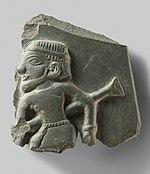
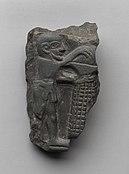
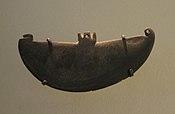
.jpg)
._Predynastic%2c_Naqada_I._4000-3600_BC._EA_37913_(British_Museum).jpg)
.jpg)

